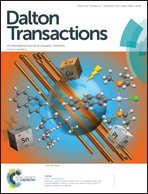Effects of composition modulation on the luminescence properties of Eu3+ doped Li1−xAgxLu(MoO4)2 solid-solution phosphors†
Abstract
Double molybdate scheelite-type solid-solution phosphors Li1−xAgxLu1−y(MoO4)2:yEu3+ were synthesized by the solid state reaction method, and their crystal structures and luminescence properties were investigated in detail. The composition modulation and structural evolution of this series of samples were studied and the selected AgEu(MoO4)2, AgLu(MoO4)2, LiLu(MoO4)2 and LiEu(MoO4)2 phases were analyzed based on the Rietveld refinement. Depending on the variation of the Li/Ag ratio in Li1−xAgxLu1−y(MoO4)2:yEu3+ phosphors, the difference in the luminescence properties of Li1−xAgxLu1−y(MoO4)2:yEu3+ phosphors was ascribed to two factors, one reason could be assigned to the coupling effect and the nonradiative transition between the energy levels of LixAg1−xLu(MoO4)2 matrices and the activator Eu3+, another could be due to the near ultraviolet energy absorption and transmission efficiency between the charge-transfer (CT) band of O2−–Mo6+ and the 4f → 4f emissive transitions of Eu3+. The ultraviolet-visible diffuse reflection spectra (UV-vis DRS) and Raman spectra analysis were also used to verify the above mechanism.



 Please wait while we load your content...
Please wait while we load your content...